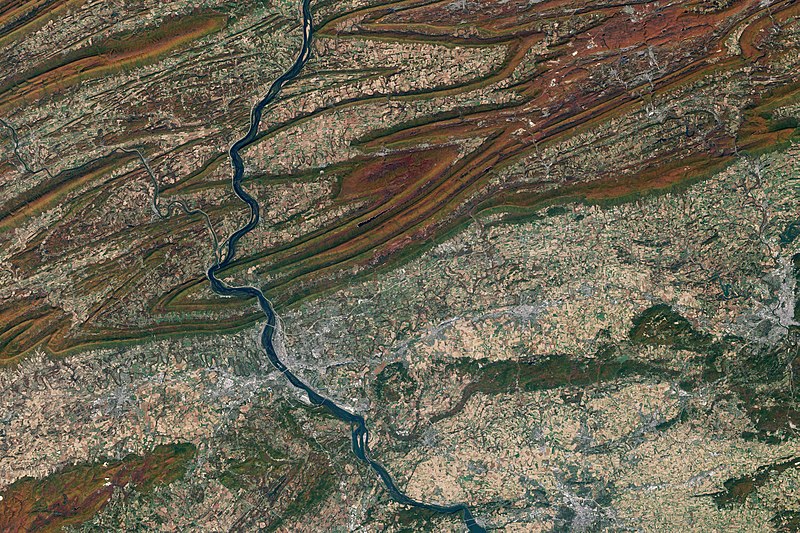File:Fall Colors in Pennsylvania (15473542687).jpg

Original file (4,319 × 2,879 pixels, file size: 5.19 MB, MIME type: image/jpeg)
Captions
Captions
Summary edit
| DescriptionFall Colors in Pennsylvania (15473542687).jpg |
Central Pennsylvania presents an ancient landscape, worn down by the grind of ice, water, wind, and time. The ridge lines of the Appalachian Mountain chain, once formidable, are now gentle folds rising over fertile valleys. Ice age glaciers shaped the land, smoothing out the mountains and depositing rich soil as the ice melted away. While the ice has done its work, this natural-color image, taken by the Landsat satellite, reveals another powerful natural force that has had a hand in sculpting the landscape: the Susquehanna River system. The river flows generally south from its headwaters in upstate New York to the Chesapeake Bay. In this image, the river cuts right through several ridge lines, apparently without regard to rock or gravity. Contrary to how things may appear at first glance, the mountains do shape the river’s course. In two places in this image, the river bends west along a ridge line until it finds a gap through which it cuts south. In every place where the river flows through the mountains, it is pouring through a gap that must have existed before. Located north of Harrisburg, Pennsylvania, which is just below the lower edge of the image, the region is called the Susquehanna Water Gap. |
| Date | Taken on 2 December 2008, 15:26 |
| Source | Fall Colors in Pennsylvania |
| Author | NASA on The Commons |
| Permission (Reusing this file) |
NASA on The Commons @ Flickr Commons |
Licensing edit
This image was taken from Flickr's The Commons. The uploading organization may have various reasons for determining that no known copyright restrictions exist, such as: No known copyright restrictionsNo restrictionshttps://www.flickr.com/commons/usage/false
More information can be found at https://flickr.com/commons/usage/. Please add additional copyright tags to this image if more specific information about copyright status can be determined. See Commons:Licensing for more information. |
| This image was originally posted to Flickr by NASA on The Commons at https://flickr.com/photos/44494372@N05/15473542687. It was reviewed on 27 September 2015 by FlickreviewR and was confirmed to be licensed under the terms of the No known copyright restrictions. |
27 September 2015
File history
Click on a date/time to view the file as it appeared at that time.
| Date/Time | Thumbnail | Dimensions | User | Comment | |
|---|---|---|---|---|---|
| current | 19:05, 27 September 2015 |  | 4,319 × 2,879 (5.19 MB) | Sumita Roy Dutta (talk | contribs) | Transferred from Flickr via Flickr2Commons |
You cannot overwrite this file.
File usage on Commons
There are no pages that use this file.
Metadata
This file contains additional information such as Exif metadata which may have been added by the digital camera, scanner, or software program used to create or digitize it. If the file has been modified from its original state, some details such as the timestamp may not fully reflect those of the original file. The timestamp is only as accurate as the clock in the camera, and it may be completely wrong.
| Orientation | Normal |
|---|---|
| Horizontal resolution | 72 dpi |
| Vertical resolution | 72 dpi |
| Software used | Adobe Photoshop CS3 Macintosh |
| File change date and time | 15:26, 2 December 2008 |
| Color space | Uncalibrated |
| Image width | 4,319 px |
| Image height | 2,879 px |
| Date and time of digitizing | 10:26, 2 December 2008 |
| Date metadata was last modified | 10:26, 2 December 2008 |